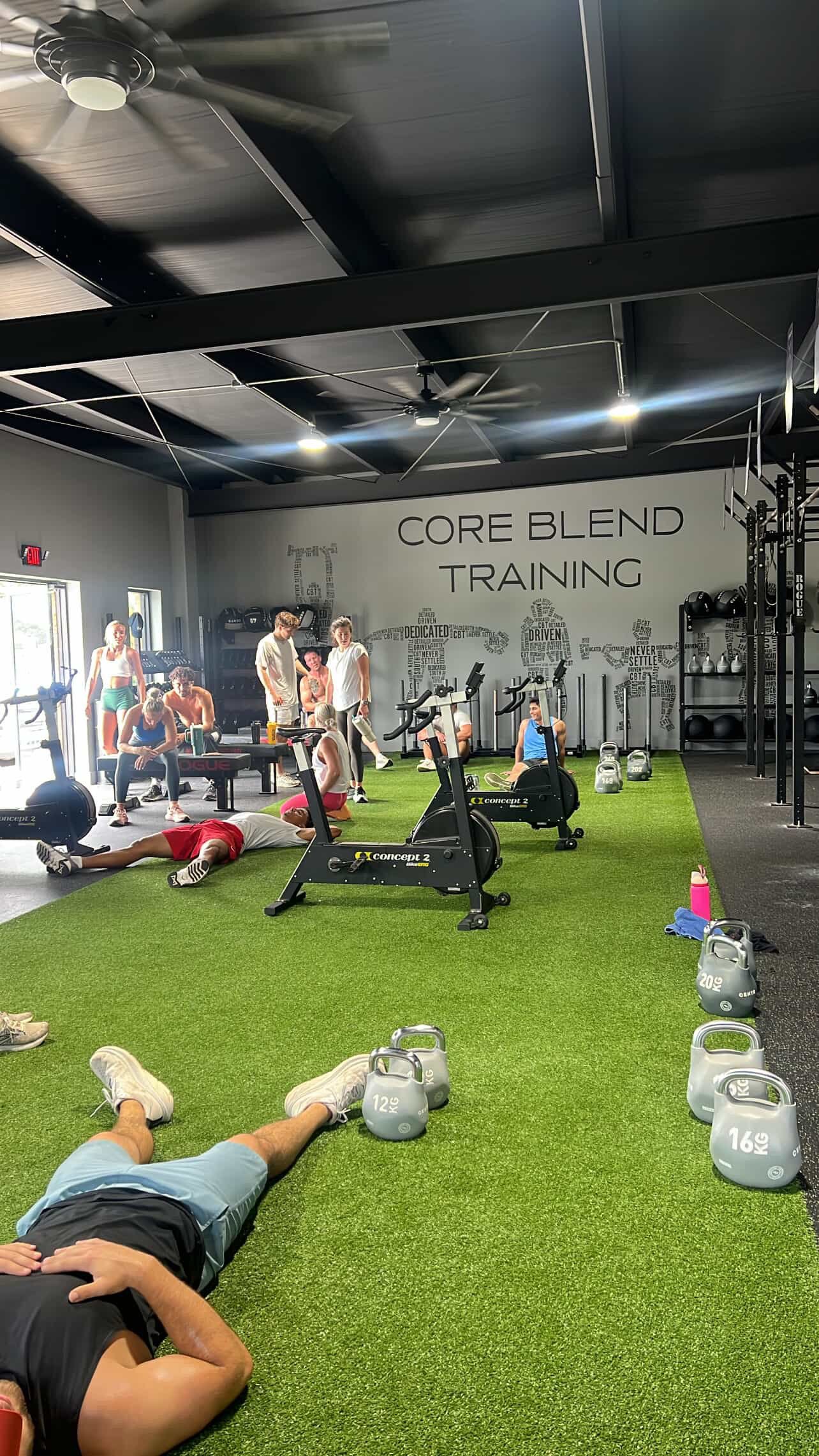What Friday took out of me—and what it gave back.
Friday: Saying Yes to Everything
Friday is usually my flex day.
It’s the day I leave open to make up a missed workout, squeeze in something low-key like tennis or yoga, or just move based on what my body needs. Monday through Thursday is pretty structured with Hyrox prep, so Friday becomes the overflow day. And apparently, I’m not the only one who knows that—because I usually get a few texts asking if I’m up for something. Tennis? Pilates? Strength circuit? I might as well start marketing myself as a freelance workout buddy. Is that a job? Because I’d apply.
This past Friday? I said yes to all three.
I kicked off the morning with about 80 minutes of tennis—part group clinic, part one-on-one rallying (aka the real cardio). Then I hopped in the car, downed an RX Bar and an Equip chocolate protein shake, and headed to the gym for something called FYF.
If you’ve never heard of it, FYF stands for “F*** Your Friday” (trying to keep it PG here), and it’s basically a team-style, soul-stealing grind session.
The Workout That Took Me Back
Here’s how it worked: two teams of about ten, each racing to reach 20,000 meters on a stationary bike. Every person took 20-second turns on the bike, followed immediately by six gorilla rows per arm. Every three minutes, the timer went off, the bikes stopped, and two runners from each team sprinted—maybe 300 meters. Once both runners made it back, the team picked up right where they left off in the push to 20,000 meters.
Teams could strategize however they wanted, which mostly meant deciding whether to alternate runners or stick with the same two people. We started with alternating the runners, and I volunteered for two out of the first three sprints. Then someone casually said, “You’ll just run every one now.”
Excuse me?
Still not sure if that was a compliment or an FYF rookie hazing. But I was competitive in that sprint, so I’m going with it being a compliment. An exhausting, brutal compliment that had me running about every two minutes—because those 3-minute windows included your run time. And the rest of your team? They’re all waiting on you to get back before the work continues. And this went on for about 40 to 45 minutes.
I won’t lie—by the end, I had to lay down during the rest periods, and I begged someone to run for me before I realized it was already over. We hit 20,000 meters on the bike just a few seconds after the other team. But we did it. And I hadn’t felt that kind of team energy in a long time. The kind where you know you’re pushing harder because someone else is counting on you. Not because you’re not motivated on your own—but because shared effort pulls something bigger out of you.
FYF aftermath. This was about 10 seconds after we hit 20,000 meters
I miss that. I grew up playing team sports—soccer, mostly—and that kind of dynamic doesn’t show up often in adult life. But Friday gave me a taste of it again. Accountability, strategy, that weird sense of pride when your whole body wants to quit but someone else is counting on you not to.
It made me think: how fun (and strategic) would a doubles Hyrox race be? Look at me—signing up for another race before I’ve even finished my first one.
I was wrecked in the best way—and fully aware that how I recovered would shape how I showed up the rest of the week.
Fueling Like I Mean It
After FYF, I pulled out a container of ground turkey, sweet potatoes, bell peppers, and spinach. Plus a lot of water. Like… a lot. Granted, I needed a few minutes. But once I caught my breath (and the room stopped spinning), I was grateful I’d packed something real.
I’ve been trying to get better about that—thinking ahead on heavy training days and actually packing food to eat. Not just whatever’s quick or convenient when I hit that starving, shaky, nothing-decent-in-sight moment. Translation: I’ve stopped pretending a single protein bar can carry me through three workouts.
So it felt like perfect timing that this week, I have plans to sit down with a Division 1 performance dietitian. I’ve been collecting questions—about fueling, recovery, timing, even supplements—and last Friday gave me a real-life case study to bring into that meeting.
I’ll share the full conversation in part two of this week’s blog—coming Thursday, June 5.
Monday: Training on Tired Legs
By Monday, my body had pretty much bounced back from Friday. I made sure to keep the weekend light—just walking, anywhere from 45 to 75 minutes on both Saturday and Sunday. Nothing structured, just enough movement to stay loose without adding load.
I had lower body strength on the calendar for Monday and decided to add running on both ends of the session—two miles before, three after.
I’ve been more intentional about training my run pace on tired legs. Everything I’ve read—and everything I’ve heard from other Hyrox athletes—points to the same thing: the run matters, probably more than most first-time racers think. And it’s not just about being able to run—it’s about being able to keep running after sled pushes, burpee broad jumps, walking lunges. So I’ve started stacking runs after strength to get my body used to running under fatigue.
What Recovery Actually Means
I've also just started to use a Garmin (the Forerunner 265, to be exact). I haven’t used a watch much in the past, but I’m starting to understand how it can help me track pacing, recovery, and effort across different types of workouts. One thing I’ve noticed? I recover pretty quickly. Part of how I notice that is being in tune with my breath. But it’s also something I can now see reflected in my heart rate data—when it spikes, and more importantly, how quickly it comes back down.
And that reminds me of something my high school soccer coach used to say. He ran us like we were a cross-country team—hill sprints, no ball in sight—and I remember thinking, “Did he forget we’re here to play soccer?” But his philosophy stuck. He used to say, "What separates you isn’t whether you’re more or less tired at the end of a sprint. It’s how fast you’re ready to go again.”
Especially as a defender, that message landed. It’s not just about how fast or hard you can go—it’s how fast you can recover. I needed to be ready to go the next time that striker made a run. Better yet, I needed to be ready before she did.
And that recovery piece? It’s not just about rest. It’s about what you do with the time between workouts—how you move, how you refuel, and how you prepare for what’s next. I’ve always been pretty good about the movement part. But the food? That’s where I’m still learning.
I mentioned earlier that I’d been trying to pack better meals on big training days—and that effort led to some bigger questions. What does good fueling actually look like? How do you know if it’s working? Where do supplements like creatine or collagen really fit in?
So this week, I called in backup. I sat down with a Division 1 performance dietitian to talk through fueling, recovery, timing, and the kind of nutrition strategies that actually hold up when you’re juggling performance goals with real life.
That conversation drops Thursday—same place, part two.

